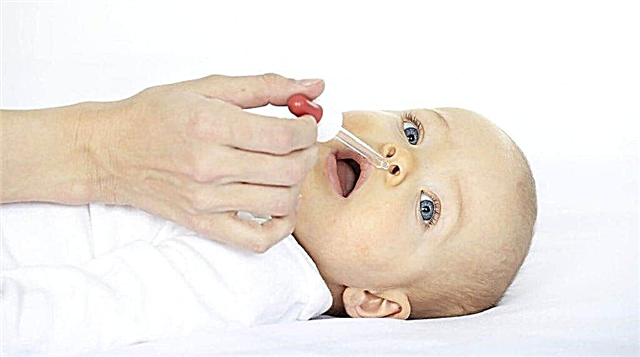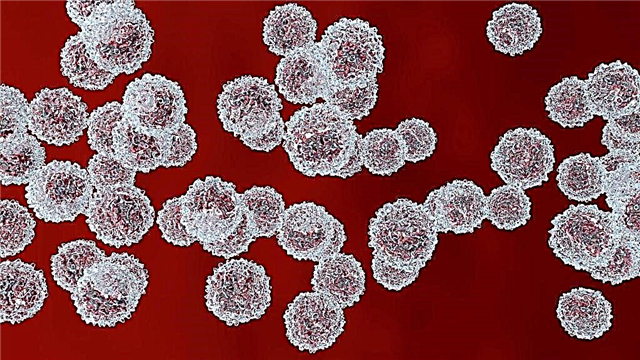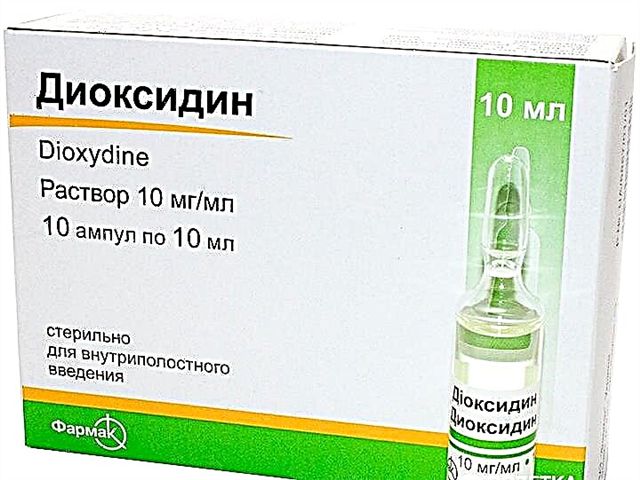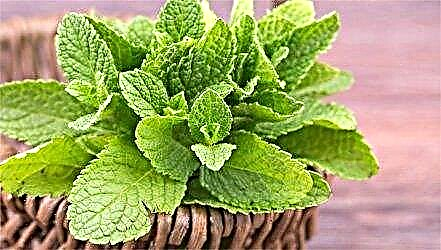Today you will not find a single child who, with acute respiratory viral infections, pediatricians would not recommend the use of saline solutions, namely saline, as symptomatic therapy. Despite the rapid development of pharmaceutical companies and the emergence of an increasing number of new drugs in the pharmacy network every day, the relevance and effectiveness of its use in clinical practice currently remains high. Saline is especially often used for inhalation and rinsing the nose.
What is saline solution? It is an aqueous solution of 0.9% sodium chloride. In everyday life, this salt is known to us as table salt. Its name "physiological" solution received due to the similarity with blood plasma and the ability to easily penetrate the tissues of the human body, as well as restore the water-salt balance. It maintains a constant pressure in blood plasma and extracellular fluid.
Saline in the practice of a pediatrician
The use of saline in the practice of a pediatrician can be attributed to one of the favorites. What is the reason for this? This question is very easy to answer: saline is considered safe for children and is approved for use from birth. It is also worth noting the low cost of this solution and the ability, if desired, to prepare it yourself at home, which is important for many parents.
Despite the wide range of drugs in the pharmacy chain, it is not easy to choose a drug that will not provoke the development of allergic reactions in children.
Currently, there is a steady increase in allergic pathology in childhood, and due to the similarity of saline with blood plasma, allergic reactions to the use of this solution are extremely rare.
Let's consider in what situations and why it is still used.

Inhalation with saline
Due to the fact that the saline solution is close to the blood plasma in salt concentration, inhalations with such a solution will not cause swelling, irritation and dryness of the nasal mucosa.
What effect do we expect when we give a child inhalations with saline? During such inhalations, the mucous membrane of the respiratory tract is moistened, liquefied and improved sputum discharge. That is, the child's cough becomes softer, a gradual transition from dry to productive cough occurs. This is our goal, and not the complete disappearance of cough.
A cough is a defense reaction and a natural mechanism for cleansing the airways, and if it is blocked, then pathogenic bacteria and viruses accumulate in the bronchi and inflammation can form, which will require more serious treatment for the child.
Formidable complications of blocking cough are the development of bronchial obstruction with the presence of respiratory failure and acute laryngotracheitis with stenosis of the larynx. Such children often become patients of the intensive care unit. Most often, in such situations, the child wakes up in the middle of the night from the fact that it becomes difficult for him to breathe.
Why is this happening? The answer is associated with the structural features of the respiratory tract in children. The trachea in young children is narrow, and its mucous membrane is abundantly supplied with blood vessels. Tracheal cartilage is easy to squeeze, soft in structure.
The lumens of the bronchi are also narrower than in adults, muscle and elastic fibers are not yet fully formed, the mucous membrane is delicate and abundantly vascularized. These features are responsible for the development of such severe complications in children.

Rinsing the nose
Saline for rinsing the nose is prescribed for everyday nasal toilet and as part of complex treatment for pathologies such as rhinopharyngitis, sinusitis, otitis media, allergic rhinitis. This helps the baby breathe easier.
What happens when you rinse your nose? At the same time, dried mucus and crusts are washed out, completely open nasal passages are preserved, the mucous membranes of the nasal cavity remain moist, and the function of the cilia improves, which helps to cleanse the sinuses. All this helps to prevent the development of inflammatory processes in the upper respiratory tract and sinuses.
The nasal passages of young children are narrower than those of an adult. The nasal mucosa is abundantly supplied with blood vessels, and the lower nasal passage is not formed. Due to these anatomical and physiological features, the lumen of the nasal cavity is easily blocked by mucus and even slight edema in case of colds, viral infections (influenza, adenovirus, rhinovirus, parainfluenza and many others), allergies make normal nasal breathing impossible in children.
Spray or drops dilute mucus, relieve swelling of the mucous membrane, stop inflammation, reduce the amount of exudate and thereby restore nasal patency. In addition, viruses, bacteria and allergens are mechanically washed away.
Carrying out the procedure for washing the nose is especially important for newborns and children of the first six months of life, since a feature of this age is a large tongue, which pushes the epiglottis backwards and makes it impossible to breathe through the mouth and children refuse to eat, stop sleeping, and are capricious.

Often it is because of a clogged nose that children of the first year of life refuse to eat and do not sleep.
It is worth noting another anatomical and physiological feature of young children - the narrowness of the choanas - the openings connecting the nasal cavity and pharynx. This causes them to have a violation of nasal breathing for a long period of time.
How to properly rinse the nose of a child under 1 year old
To do this, lay the baby on its side, clean the nose from the crusts with a moistened cotton flag, then drip 2 drops of solution into one nostril using a pipette or a regular syringe (without a needle). Then turn the child on the other side and do the same with the second nostril.
Wait until the solution drains a little and suck out the mucus using a rubber bulb or a nasal aspirator, since children under 2 years old do not know how to blow their nose themselves. However, you should not get carried away with the use of aspirators either - this can injure the nasal mucosa. This procedure is sufficient to perform 2 times a day.
From the age of 3, the child can already tilt his head over the washbasin. The nose is pre-cleaned with cotton filaments, then a stream of solution is directed to the inner surface of the nasal cavity with a syringe or pear. The solution flows out on its own along with mucus and crusts, the procedure continues until a pure solution without impurities appears.
Other points of application
Saline is used:
- as a universal solvent for inhalations with medicinal products (for example, berodual, pulmovent combi, berotec, pulmicort, bodyinet, lazolvan, ambrohexal);
- as part of infusion therapy. This is the most commonly used solution in droppers for dehydration (dehydration) to restore water-electrolyte disturbances, in intoxication, to replenish the volume of fluid with heavy bleeding, with severe burns, shock conditions. It can be used both as an independent solution and as part of other crystalloid solutions;
- as a solvent for dilution of antibiotics and their intravenous administration;
- present in various oral rehydration solutions (that is, a component of solutions for drinking a child);
- toilet eye with their inflammatory diseases;
- to treat wounds;
- use as a solvent for intramuscular injection is acceptable drugs in patients with allergic reactions to local anesthetics (lidocaine, novocaine), but in view of the severe pain of such injections, it is now rarely used.
Saline solution for inhalation - buy or prepare
The fundamental difference between the prepared solution at home and the pharmacy is the lack of sterility.
For rinsing the nose, it is not essential that saline solution was purchased at the pharmacy or prepared at home. To perform inhalations with this solution, it is still preferable to use a sterile pharmaceutical solution, since the vapors of the saline solution penetrate deep into the bronchi.
Preparing saline at home
Preparing saline at home is not difficult and everyone can do it. To do this, mix 1 teaspoon or 9 g of table salt and 1.0 liter of warm boiled or distilled water.
The resulting solution can be stored for no more than 24 hours from the moment of preparation in the refrigerator.

If you buy at a pharmacy - which one is better to choose
You can find saline in any pharmacy in the form of ampoules of 5, 10, 20 ml or bottles of 100, 200, 400 ml. An indisputable plus of purchasing an industrial solution is its sterility and, as a result, its versatility.
On pharmacy counters for washing the nose, it is also known under the names "Salin", "Rinolux", "No-salt", "Rizosin" and others.
Today, sea salt preparations occupy a huge niche in the pharmacy range. These are "Humer", "Aqualor", "Aquamaris", "Kviks", "Aquasol", "Morenazal", "Otrivin Sea", "Physiomer", "Humer" and others. They are available in various forms for children of all ages and adults. For children's forms, the name always contains the prefix "baby".
In essence, these are preparations made on the basis of sea water from the Atlantic, the Adriatic Sea. That is, according to the principle of their action, despite the difference in price and manufacturer, they are similar to saline. The main difference is that in addition to salt, they contain various trace elements. Such drugs are represented by lines of isotonic and hypertonic solutions.
Isotonic solutions are in essence a saline solution. A hypertonic solution is a solution with a high salt content (approximately 2.2%). Due to this, it more "pulls" the liquid from the cell from the inner surface of the nose, quickly relieves swelling and has a stronger bactericidal effect.
Such solutions are used only for the treatment of rhinitis, sinusitis, otitis media, adenoiditis as part of complex therapy. They should not be used for young children and should not be used for a long time.
Their indisputable disadvantage is their high cost. Therefore, if you cannot afford to purchase these drugs, then you should not chase them.
When choosing one or another solution for rinsing the nose or treatment, it is necessary to know that in young children, the Eustachian tubes are wide, therefore, with the accumulation of mucus in the nasal cavity and the use of sprays and aerosols, the inflammatory process easily spreads further into the lumen of the middle ear. As a result, there are eustachitis, otitis media.
For children under 5 years old, it is preferable to use drops as a release form. In children under 1 year old, sprays and aerosols are categorically contraindicated!

Indications for inhalation with saline
Mostly the use of inhalations with saline is indicated for diseases manifested by the presence of a dry cough. Their appointment is also possible with an unproductive cough.
Age
There are no age restrictions for the use of inhalations with saline, that is, they can be used from birth.
Diseases
- Laryngotracheitis / tracheitis.
- Rhinopharyngitis.
- Bronchitis.
- Pneumonia is resolving.
- Bronchial asthma and others.
Contraindications for inhalation with saline
- Individual hypersensitivity.
- Predisposition to nosebleeds.
- Arterial hypertension.

Inhalation technique in children
First, you need to wash your hands and pour the required volume of the drug solution into a special reservoir and collect it according to the manufacturer's instructions. Then sit the child in a convenient way. Most often, young children are more comfortable sitting on their parents' lap.
Children under 1 year of age wear a face mask so that it covers the nose and mouth completely. Older children can hold the mask tightly against the face, capturing the nose.
The child should breathe during inhalation naturally, exhale through the mask. It is necessary to ensure that the reservoir with the medicine does not tilt more than 45 degrees, otherwise the medicine may leak out and such inhalation will not be successful.
Manufacturers of modern models of inhalers strive to make the inhalation as comfortable as possible for the child. Silent devices appear, the speed of conducting increases, various forms of devices are developed in the form of cartoon characters, animals, supplemented with pleasant melodies and songs.
In addition, during inhalation, you can read a fairy tale to your child, turn on a cartoon or give your favorite toy.
Inhalations are usually performed 2 to 4 times a day. The duration of one inhalation is on average 5-10 minutes. The volume of the solution required for one inhalation is 2.5-3.0 ml.
The duration of inhalation may vary depending on the type of inhaler and its manufacturer. It is important that the child breathes the entire volume of the filled solution completely.
At the end of inhalation, it is necessary to disassemble the inhaler, treat the mask and the reservoir for medicinal substances with a disinfectant and water, and wash your hands.
Nebulizer and saline
Earlier, before the advent of nebulizers, the so-called "steam inhalation" was used. And today there are steam inhalers on sale, as well as earlier used improvised means, such as inhalation over steam, over hot potatoes.
Some still use such techniques. However, this is dangerous due to the fact that hot steam is inhaled by the development of a burn of the mucous membrane of the nasal cavity and they cannot be used if there is a temperature above 37.5 C. Inhalation with cold steam is considered safer. The disadvantage of the old methods is also considered to be the limited spectrum of action by the upper respiratory tract.
It is considered safer for children to inhale with a nebulizer. A nebulizer is a device that converts a drug solution into a finely dispersed mixture with a powerful stream of air and ensures its delivery to the upper and lower respiratory tract. That is, in fact, the drug is broken down into many very small aerosol particles.
Today, the market offers a huge selection of nebulizers of different characteristics and price categories. Consider what they are.
Types of nebulizers
Compressor nebulizer
It is considered the most optimal for home use. It contains a compressor that, when air passes through a narrow opening, breaks the drug solution with a powerful stream of air into the aerosol cloud, which reaches both the upper and lower respiratory tract.
Suitable for the use of almost all drugs in children of different ages. It is considered reliable and affordable. The disadvantage of this type of nebulizer is that it is noisy and bulky.

Ultrasonic nebulizer
Ultrasonic waves break the drug into tiny particles that reach the lower respiratory tract.Due to the fact that many drugs (hormones, antibiotics) are destroyed by ultrasonic waves, the range of its application is less than that of other nebulizers.
The advantage of this type of nebulizer is its quiet operation and compactness.
Mesh nebulizer (mesh)
It appeared on the market relatively recently, but immediately proved itself well and began to be in great demand. In this type of nebulizer, nebulization is performed with a vibrating mesh. It is ideal for use in young children due to its quietness, high speed of inhalation. After all, the smaller the child, the more difficult it is for him to inhale.
The size of the device is quite compact, which allows you to perform procedures not only at home, but also to take with you on trips. Suitable for almost all medications. There is an automatic shutdown function in the absence of a drug in it, and the sprayed particles reach the smallest size.
Some manufacturers of such devices supplement them with such a child-friendly function - inhalation music.
The downside is the high cost of this device.
Rules to achieve the expected effect
- Make sure that the reservoir with the medication does not tilt more than 45 degrees and the solution simply does not leak out.
- Make sure that the mask fits snugly over the child's face and covers his nose and mouth. Otherwise, the solution will pass by.
- Also important is the positive attitude of the parents towards inhalation. After all, if the parents are negative and skeptical, then the child will also worry, and the effectiveness of inhalation will decrease.

Precautions when performing inhalation in children
Remember, that:
- inhalation should not be carried out less than 1.5 hours after a meal. This can provoke vomiting in the child;
- inhalation should not be performed at high temperatures (37.5 C and above). Let us dwell on this point in more detail. In clinical practice, we often see that many parents do not correctly understand this statement, the child is left without proper treatment as a result, and he often develops formidable complications. The presence of a high temperature in a child does not mean that it is completely contraindicated for him to carry out inhalations prescribed by a pediatrician. This means that you must give the child an antipyretic agent, wait for the temperature to drop, and then inhale. The ban on inhalation in the presence of a high temperature in a child worked when steam inhalation was actively used. In modern nebulizers, there is a cold air stream;
The last inhalation should be carried out a maximum of 3 hours before bedtime. Otherwise, the child will cough instead of sleeping.
- you shouldn't walk outside within 2 hours after inhalation;
- it is not recommended to feed the baby immediately after inhalation;
- don't experiment on your own and add additional drugs to the solution that were not prescribed by the pediatrician.
Are there any adverse reactions to saline
Adverse reactions to saline are extremely rare and usually include individual hypersensitivity reactions in the form of rash, chills, hypotension, and fever.
This is due to its similarity to blood plasma.
Conclusion
The use of saline in children's practice does not lose its relevance today. This is primarily due to its effectiveness, availability, good portability, low cost and ease of use.
Why reinvent the wheel when you can ride it? Sometimes simple treatments will produce the best results. Follow the advice of your pediatrician and do not self-medicate.



